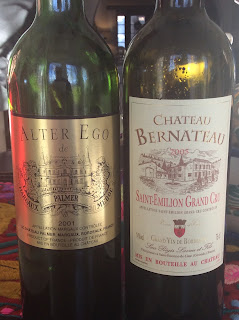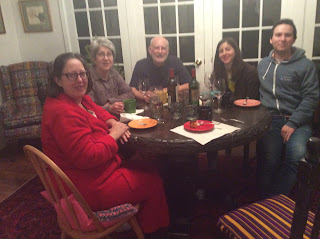We slept in until about 9:00. At 10:00 Willy, Suzette, and I drove to Gutiz in El Prado. It is a French style restaurant. Suzette and I ordered a Crepe filled with a slice of ham, Brie cheese, and scrambled eggs with a small salad. I asked and was served toasted French bread with butter snd housemade orange marmelade.
Willy ordered a Taoseno bowl with three kinds of beans, tomatoes, scrambled eggs and rice.
The crepe was thick, not like the tender think French ones I was expecting.
After brunch we drove to Teaography off Kit Carson and tasted teas. Suzette bought 6 oz. of beautiful teas. One was Blake, a spice tea with turmeric and cardamon and the other was a white Earl Grey tea made with white tea and bergamot.
We then drove to the Plaza and walked the short block to Chokala. We each ordered a 5 oz. cup of hot chocolate. Willy ordered Maya with Chile, Suzette ordered Aztec with cardamon, and I ordered French Vanilla. We were energized after our hot chocolate, so we walked to Parsons Galley and talked to Robert Parsons Gallery and talked to him for a while.
We then drove back to the rental and said goodbye to Willy, who drove back to Albuquerque. We then drove to Pieces, the consignment store. Suzette found some interesting furniture pulls and I found a Kenneth Adams print and a Scottish cashmere sweater vest
We then drove to 203 Gallery and talked with Eric, who showed me that I bought an offset print with practically no value by looking for the little dots.
By 3:00 we were tired so we drove back to the rental and rested until 4:30, when we drove to the Cellar wine store for two flights of wine tastings. The first was by the store and featured a Cremante de Alsace, a light bubbly fruit bomb. I loved it. The other white was a very unique wine from Savoire made from Jacquere grapes that I had never had before. It was equally interesting. The last
two were reds. One was a Cabernet Franc from Chinon, in the Loire that is considered the best
growing area for Cab. Franc and the other red slips my memory at the moment.
the Cremante de Alsace
The Jacquere from Savoie
Abraxas is a reaction against homogeneity and a salute to distinctiveness. Born of the idea that four grapes traditional to Alsace (Riesling, Pinot Gris, Pinot Blanc and Gewürztraminer), planted in RSV’s Organic Scintilla Sonoma Vineyard, would respond distinctly to the changing weather
patterns. of each year. The four varieties could then be blended in ratios determined by each variety’s unique response to the vintage, making the wine whole, while avoiding the manipulations often found in a more industrialized cellar. Abraxas does not aspire to be anything but true to vintage.
The start of the 2015 vintage was unseasonably warm from late winter through early spring for an early bud break and bloom. It was relatively dry with 75% of “normal” rain for the season. Colder temperatures during May bloom resulted in an uneven fruit set and a smaller crop in general. This drought vintage produced lower average cluster weights and grapes with thicker skins for above average structure and intense flavor for each variety.
The warm, dry weather combined with the smaller clusters led to an early harvest with all white grapes entering the cellar door by the second week of September. All the white grapes were harvested in the cool of the night to arrive at the cellar cold for whole cluster pressing. Each variety and vineyard block was picked separately at quintessential ripeness and fermented for 28-30 days in stainless steel tanks.
He also tasted another unusual white named Orgia that combined oak aged Pinot Gris with steel tank aged Pinot Gris. Here are his notes on this wine:
Orgia is an ongoing experiment in enlightenment. Wine is mostly about aroma and flavor, but what if the tactile or textural qualities were just as important? Orgia, being made from Pinot Gris grown in RSV’s organically farmed Three Amigos Vineyard, is about the most exciting wine you can put in your mouth.
Pinot Gris is an odd grape. In the vineyards, it looks like a rusty grape with a grayish, reddish-brown tint. Yet if you press it off the skins before fermentation, it will make a clean, bright, almost colorless white wine. But if you allow the grapes to ferment on their skins, the wine takes on a copper color
(Italians call it “ramato”) and extracts some tannin from the skins to lend the wine texture and age-worthiness.
Optimally ripened Pinot Gris is night harvested by hand, destemmed, and then fermented on the skins. Winemaker Jeff Virnig uses several different techniques to naturally extract color and texture from the grapes, yet all of the individual lots are allowed to ferment on native yeast.
The 2014 vintage was the third in a string of dry but stunningly beautiful vintages. The ’14 produced less fruit than the two prior, with smaller berries and thicker skins, for an even more intense mouth feel.
Wine Tasting Notes
Orgia is a trip. A bright, vibrant wine with the initial impression of a white and the gravitas of a red. The wine has a beautiful copper hue gleaned from skin contact during fermentation. The aroma is effusive with a wonderful medley of orange blossom, honey, crisp apple, and tea. The aroma follows
through on the palate with the added impression of saltiness that implies this wine would be
incredible with seafood. The tannin from the skin contact is apparent and lends the wine a mineral weightiness with incredible depth and length that just keeps going further, suggesting this wine will age gracefully for generations.
Then we tasted a Robert Sinsky Pinot Noir and a Cabernet Sauvignon. Both were great.
Robert said all the wines were from grapes grown in Carneros except the Cab, which is raised in the Stag’s Leap subregion of Napa Valley, where the Winery is located.
I was impressed with Robert’s total assurance in what he is doing including his total commitment to making great wine and pushing the envelope to make new interesting wines.
At 5:45 we were done and returned to the Posada to make dinner.
Elaine snapped the two lb. of green beans and made the rice. Billy finished the sour cherry sauce. Mickie and Rebecca sautéed the duck breasts slowly and rendered the fat as soon as it accumulated. We opened the two bottles of wine, a 2001 Chateau Palmer Alter Ego de Margaux, Appellation Margaux Controlee ( a $100.00 bottle per Wine Searcher) although only garnering an 87 or three star rating that is apparently Chateau Palmer’s second label and a bottle of 2005 Chateau Bernateau, Saint Emillon Grand Cru that Wine Searcher rates 89 points and 3 1/2 stars at an average price of $22.00.
Both were Bordeaux red blends suggested for beef and venison, so appropriate for duck.
Sautéing the duck breasts
The sour cherry sauce
We ate a lovely dinner and after dinner we made coffee and tea and sliced pieces of Elaine’s clementine and almond flour cake with a chocolate glaze icing that was gluten free and dairy free.
Here is the recipe for the Clemintine Cake
Our dinner
We rested and went to bed after dinner.
Bon Appetit

















No comments:
Post a Comment